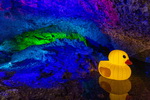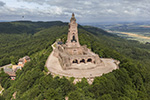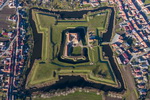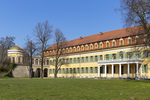Medieval ruins can be seen on the hill above the town, so we headed there. There is no old town with half-timbered houses, but the centre looks pleasant.
There is water everywhere in the city, including fountains and streams.
There are even foot baths near where we parked.
Next, we walked through the resort park to the leaning church (Schiefe Turm).
This is an interesting landmark, with a greater inclination than the Leaning Tower of Pisa. Its construction began in the 13th century, and for a long time it was the city's main temple.
For centuries, salt was mined beneath the church, creating underground cavities and causing the foundation to gradually sink. It has long been closed and is no longer used for its original purpose, and the church tower is tilted approximately 4.6 metres from the vertical. Work is currently underway to stabilise the structure in order to preserve it as an architectural monument. You can see how the tower is being reinforced with huge supports.
From the church, we climbed even higher, to the Hausmannsturm tower. It was built in the 14th century as part of the city walls. This is the so-called Watchtower, where the watchman stood guard, looking out for fires or the dangerous approach of enemies.
If you go even higher, you can reach the Panorama Museum, which houses Werner Tübke's panorama ‘Peasants' War in Germany,’ depicting the events of the Peasants' War of 1525.
There are different routes up and down to the tower, some with flowers, others with obstacle courses.
On the way back, we visited the Elisabeth Spring, named after Queen Elizabeth of Prussia. It was this spring, opened in 1818, that turned the town into a resort.
Getting there: there are many car parks in the town; we parked here 51.356361, 11.102167. The nearest railway stations are Heldrungen, Sondershausen or Artern, from where you can take a bus to Bad Frankenhausen.
























